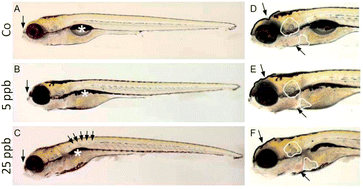Analysis of protein expression in developmental toxicity induced by MeHg in zebrafish†
Abstract
Mercury toxicity and its implications in development are a major concern, due to the major threat to ecosystems and human health that this compound represents. Although some of the effects of methylmercury (MeHg) exposure have been extensively studied, the molecular mechanisms of interaction between this compound and developing organisms are still not completely understood. To provide further insights into these mechanisms, we carried out a quantitative proteomic study (iTRAQ) using zebrafish larvae exposed to 5 μg L−1 and 25 μg L−1 MeHg as a model. In this study, a multidimensional approach combining


 Please wait while we load your content...
Please wait while we load your content...